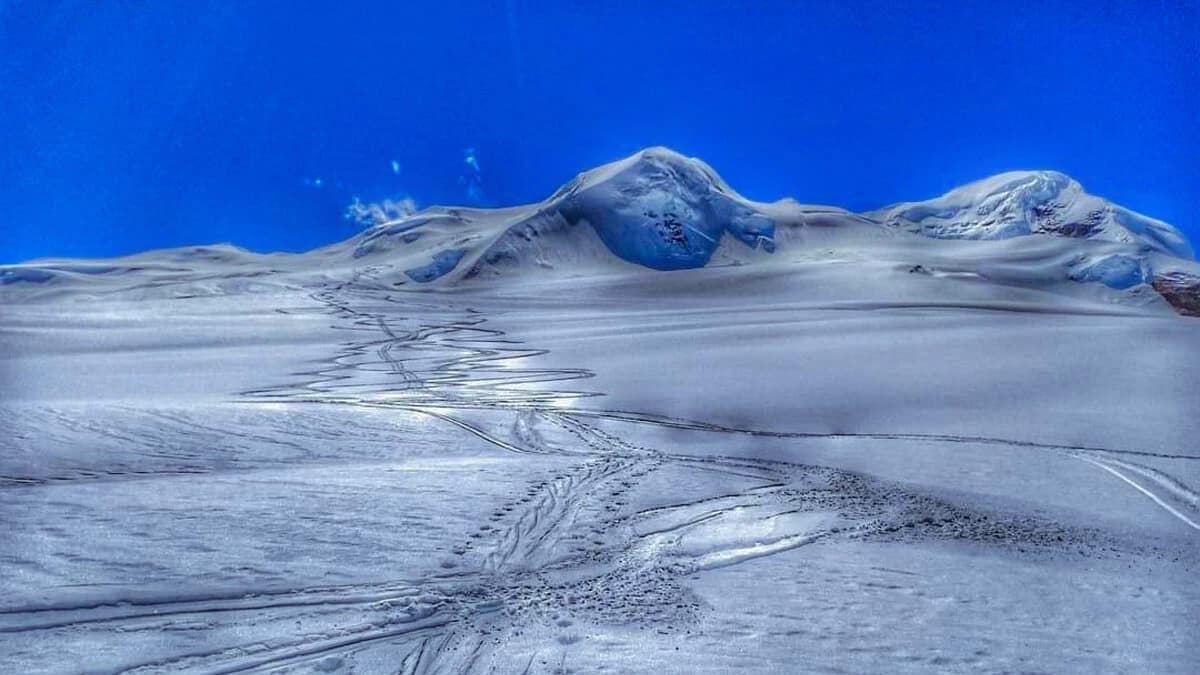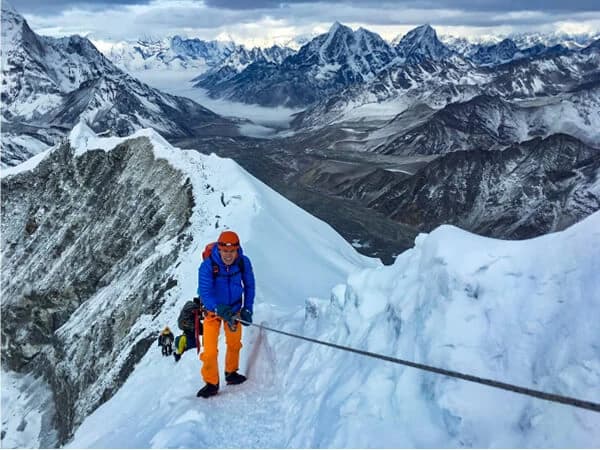Mera Peak, located in the Sankhuwasabha district and Sagarmatha region of Nepal, is the highest trekking peak in the country, standing at 6,476 meters (21,247 feet). Positioned in the Mahalangur section of the Himalayas, Mera Peak offers climbers an accessible adventure with relatively straightforward technical requirements, making it a popular choice for both novice and experienced mountaineers. The climb, while not highly technical, does necessitate basic mountaineering skills, including the use of crampons, ice axes, and ropes. From the summit, climbers are rewarded with stunning panoramic views of some of the world's highest peaks, including Mount Everest, Lhotse, Cho Oyu, Makalu, and Kanchenjunga.
The expedition typically begins with a flight from Kathmandu to Lukla, followed by a trek through scenic Sherpa villages, lush forests, and high alpine landscapes. Acclimatization is a critical component of the journey due to the high altitude, with several days allocated to help climbers adjust and reduce the risk of altitude sickness. The best times to climb Mera Peak are during the pre-monsoon (April to early June) and post-monsoon (late September to early November) seasons, when the weather conditions are most stable and favorable for climbing.
The trek to Mera Peak also provides a rich cultural experience, as climbers pass through traditional Sherpa communities and traverse Makalu Barun National Park, which is home to diverse flora and fauna. For safety and logistical support, hiring experienced guides and porters is recommended. Necessary permits for the expedition include a Mera Peak climbing permit, a Makalu Barun National Park permit, and a TIMS card. Mera Peak combines the thrill of high-altitude climbing with cultural immersion and natural beauty, making it a memorable and rewarding adventure for those who undertake it.
Highlights
Mera Peak is a unique blend of adventure, cultural immersion, and natural beauty, making it a memorable destination for trekkers and climbers.
Panoramic Summit Views: The summit of Mera Peak offers breathtaking 360-degree views of five of the world’s highest peaks: Mount Everest, Lhotse, Cho Oyu, Makalu, and Kanchenjunga. This stunning vista is a major draw for climbers.
Accessible Climb: Mera Peak is considered one of the more accessible trekking peaks in Nepal, making it an excellent choice for novice climbers looking to experience high-altitude mountaineering. The climb requires basic technical skills and equipment like crampons, ice axes, and ropes.
Scenic Trekking Route: The journey to Mera Peak takes trekkers through picturesque Sherpa villages, lush rhododendron forests, and high alpine meadows. The route is rich in natural beauty and offers diverse landscapes.
Cultural Experience: Trekkers have the opportunity to immerse themselves in the unique Sherpa culture by visiting traditional villages and monasteries and experiencing the warm hospitality of the local people. This cultural interaction adds depth to the adventure.
Flora and Fauna: The trek passes through Makalu Barun National Park, which is home to a variety of flora and fauna. Trekkers may encounter wildlife such as the Himalayan tahr and red panda, as well as vibrant rhododendron forests.
Acclimatization and preparation: The expedition is structured to allow for proper acclimatization, reducing the risk of altitude sickness. This careful approach ensures climbers are well prepared for the summit push.
Best Climbing Seasons: The most favorable times to climb Mera Peak are during the pre-monsoon (April to early June) and post-monsoon (late September to early November) periods. These seasons offer stable weather conditions and clear skies.
Logistical Support: Experienced guides and porters are available for hire, providing essential logistical support, safety, and local knowledge. Their expertise can significantly enhance the success and enjoyment of the expedition.
Permits and Regulations: Climbing Mera Peak requires several permits, including a Mera Peak climbing permit, a Makalu Barun National Park permit, and a TIMS (Trekkers' Information Management System) card. These permits are relatively straightforward to obtain, ensuring a smooth expedition process.
Physical Challenge and Reward: Climbing Mera Peak presents a significant physical challenge, requiring good fitness and endurance. Successfully reaching the summit is a rewarding experience, providing a sense of accomplishment and adventure.
What should I expect during the Mera Peak climb?
Commencing on the Mera Peak climb, you can expect a comprehensive and adventurous journey. Your experience begins in Kathmandu with permit preparations, equipment checks, and briefings about the trek and safety protocols. A scenic flight from Kathmandu to Lukla marks the start of your trek through the Everest region, where you'll walk through lush forests, terraced fields, and traditional Sherpa villages. Daily trekking involves 4–7 hours of walking on varied terrain, with overnight stays in teahouses offering basic amenities. Acclimatization days are scheduled to help prevent altitude sickness, and you'll have opportunities to engage with the local Sherpa culture and enjoy local cuisine.
As you approach Mera Peak Base Camp, you'll traverse high alpine terrain with stunning views of glacial lakes and towering peaks. The base camp is where you'll prepare for the summit push, including gear checks and practice sessions. The summit attempt starts early in the morning from High Camp at 5,780 meters, involving trekking over snow and ice using crampons, ice axes, and ropes. Reaching the summit offers breathtaking panoramic views of the Himalayas, including Everest, Lhotse, and Makalu. After the summit, you'll descend back to High Camp and then to Khare.
The return journey follows the same route back to Lukla, allowing time to enjoy the landscapes and reflect on your achievement. Once back in Kathmandu, you can celebrate your success, explore the city, and participate in a debriefing session with your guides. Throughout the expedition, expect long days of trekking, varying weather conditions, and the physical demands of high-altitude climbing. Staying hydrated, eating well, and listening to your body are crucial for maintaining health and safety. Flexibility and patience are essential due to the unpredictable nature of mountain weather. Overall, the Mera Peak climb offers a challenging yet rewarding adventure, combining physical exertion with cultural immersion and breathtaking natural beauty.
Is Mera Peak climbing right for you?
Deciding whether Mera Peak climbing is right for you involves evaluating your physical fitness, mountaineering experience, and personal aspirations. This expedition demands good cardiovascular fitness, strength, and stamina due to long days of hiking and significant altitude gain. While Mera Peak is non-technical, previous high-altitude trekking experience is beneficial, and basic mountaineering skills like using crampons, ice axes, and ropes are required, though these can be learned with guidance from experienced leaders.
Mental resilience is crucial, as you'll need to handle the physical demands, potential discomforts such as cold temperatures and high winds, and the need for flexibility due to weather changes. If you seek a challenging high-altitude adventure with stunning natural beauty and rich cultural experiences, including interactions with Sherpa communities and panoramic views of peaks like Everest and Lhotse, Mera Peak is an excellent choice.
However, it requires a significant time commitment of about 18 days and a budget of $2,000–$4,000 or more, depending on the level of support you choose. If these factors align with your capabilities and goals, Mera Peak can offer a rewarding and memorable climbing experience.
And if you are looking to enhance your trekking experience, consider integrating the Chola Pass Trek or the Everest Base Camp Trek into your Mera Peak climbing itinerary for an unforgettable adventure.
Perks of doing the Mera peak climbing trek with us
Climbing Mera Peak with Sherpa Eco Adventure offers professional support, safety, convenience, and a richer cultural experience, making it a highly recommended option for both novice and experienced climbers.Choosing to climb Mera Peak with us offers several significant perks that enhance safety, convenience, and the overall experience. Here are some of the key benefits:
Professional Guidance and Support
Experienced Guides: Sherpa Eco Adventure provides professional guides who are knowledgeable about the route, weather conditions, and altitude-related challenges. Their expertise ensures a safer and more enjoyable climb.
Support Staff: Sherpa Eco Adventure often includes porters and support staff who carry heavy equipment and supplies, allowing you to focus on the climb and enjoy the journey.
Safety and Medical Support
Emergency Preparedness: Sherpa Eco Adventure is equipped to handle emergencies with first aid kits, oxygen supplies, and evacuation plans. Guides are trained in recognizing and managing altitude sickness and other medical issues.
Insurance: Sherpa Eco Adventure offers travel insurance options that cover emergency evacuations, medical treatment, and trip cancellations, providing peace of mind.
Logistics and Permits
Permit Arrangements: Sherpa Eco Adventure handles the hassle of obtaining necessary permits, such as the Mera Peak climbing permit, Makalu Barun National Park permit, and TIMS card, ensuring all legal requirements are met.
Accommodation and Meals: Sherpa Eco Adventure arranges for accommodations in teahouses or lodges along the route and provides meals, ensuring consistent and reliable service.
Proper Acclimatization
Planned Itinerary: Sherpa Eco Adventure designs itineraries that include proper acclimatization days, reducing the risk of altitude sickness and increasing your chances of a successful summit.
Health Monitoring: Guides monitor your health and acclimatization progress closely, offering advice and adjustments to the itinerary if necessary.
Equipment and Training
Gear Provision: Sherpa Eco Adventure provides or rents necessary climbing gear such as crampons, ice axes, ropes, and harnesses, ensuring you have the right equipment for the climb.
Training Sessions: Agencies often offer pre-climb training sessions to familiarize you with the use of technical gear and basic mountaineering techniques.
Cultural and Environmental Insights
Local Knowledge: Guides share insights about the local culture, traditions, and natural environment, enriching your trekking experience with stories and information about the Sherpa communities and the region’s flora and fauna.
Sustainable Practices: Reputable agencies follow sustainable tourism practices, minimizing environmental impact and supporting local communities.
Convenience and Comfort
Organized Travel: Sherpa Eco Adventure manages all logistical details, including flights, transfers, and accommodations, allowing you to focus on the experience rather than the logistics.
Group Dynamics: Through camaraderie and sharing of experiences with other trekkers, taking part in a group trek put on by an organization can improve the experience.
Stress-Free Experience
Comprehensive Service: From the moment you arrive in Kathmandu until the end of your expedition, the trekking agency takes care of all details, making the entire experience smooth and stress-free.
Post-Climb Arrangements: Sherpa Eco Adventure often includes post-climb activities, such as celebratory dinners, cultural tours in Kathmandu, and debriefing sessions, adding value to your trip.


